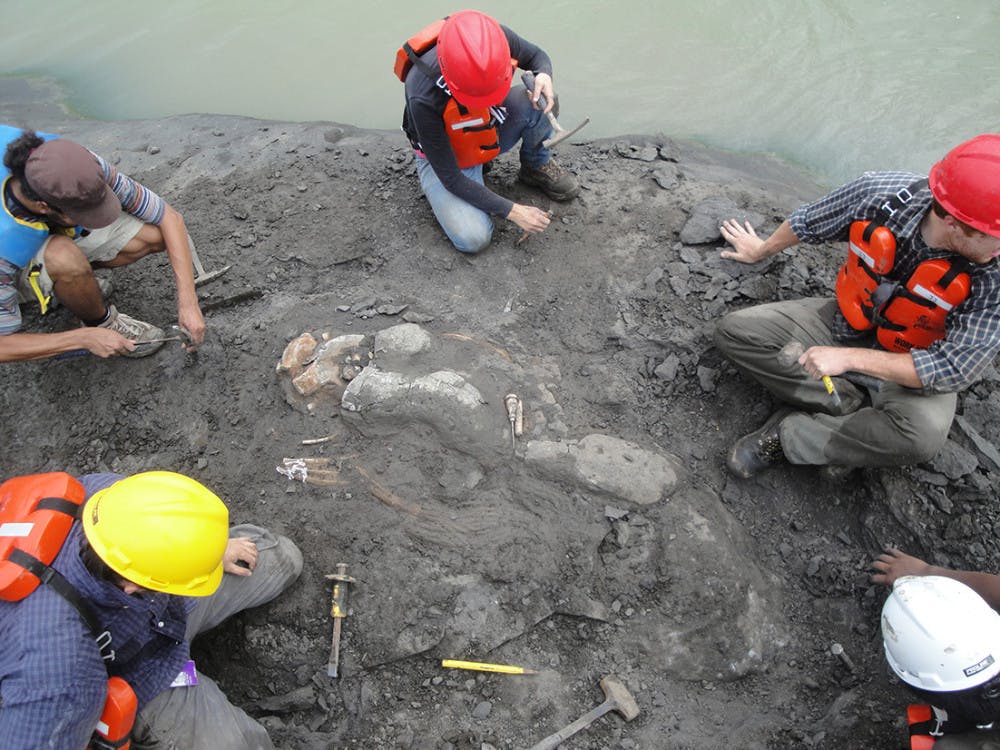Steven Manchester had no clue a discovery seven years ago would be the oldest and first of its kind.
Manchester, 62, a curator and professor of paleobotany at the Florida Museum of Natural History, was searching for fossil plants along the Panama Canal when he came across a bone of a sea-tusked cow.
It wasn’t until Feb. 18 of this year he learned it was a 20-million-year-old fossil of Central America’s oldest marine mammal, Culberatherium alemani, a tusked seagrass-grazing relative of modern dugongs.
Manchester was shocked to learn the significance of the fossil but said it’s always thrilling to discover new history.
“I once found the world’s oldest banana in the 1980s in Oregon,” Manchester said. “Every year, I’m collecting more fossils.”
In 2012, Manchester decided to stray away from his group to explore on his own. The waves crashing along the canal were dangerous enough to sweep a person offshore, he said.
“Fortunately, I didn’t fall into the canal waters and drown,” Manchester said. “By being so close to the water’s edge, I had trespassed into a forbidden area due to safety concerns.”
After an hour of searching on the shore, Manchester spotted a skeleton sticking out of a rock exposure.
He immediately took note of the location. He rushed back to find his group so he could alert the specialists in vertebrate paleontology, those who study fossilized vertebrae or skeleton rods.
“I guessed it might be something commonly found before,” Manchester said. “But I wanted to have the bone experts decide for themselves.”
There were two or three vertebrae, slightly orange in color, dipping into the black rock on the side of the canal with a couple of ribs around them, said Aaron Wood, a lecturer and director of the Iowa State University Geology Field Station who was on the expedition.
The team guessed there would be more embedded under the rock, Wood said. They immediately called for an emergency fossil excavation, which is the digging up of a fossil because of rising water levels. The entire process took a few days.
“I didn’t realize the significance, nor the amount of effort that would be required for the crew to expose and extract the bones,” Manchester said.
It wasn’t until Manchester returned to Gainesville a few days later that he heard when people continued to dig the fossil up back in Panama, there was a skull attached to the initially exposed ribs.
“Only then did I realize that the discovery could be significant,” Manchester said.
The 15-foot-skeleton of an ancient sea cow is believed to be the first evidence of a marine mammal from the Pacific side of the canal, Manchester said.
Luck was on Manchester’s side, Wood said.
“Discovering new fossil species is, in many ways, like winning the lottery,” Wood said. “You have to play for a very long time before you win, and when you do, it’s amazing.”
Manchester’s findings are now being stored in the Florida Museum but not on public display, said Richard Hulbert Jr., Vertebrate Paleontology Collections manager at the Florida Museum.
Some fossil specimens are stored away from public viewing because they have greater scientific value and can be used for research, Hulbert said.
“This is so they will always be available for study by future researchers,” Hulbert said.
The fossil is an addition to the Florida Museum’s collection of scientific findings, said Jorge Velez-Juarbe, an assistant curator of marine mammals at the Natural History Museum of Los Angeles County.
“When I first saw the specimen, I immediately knew it was something new and would change what we knew about the fossil record of the group,” Velez-Juarbe said. “This new specimen adds a whole new perspective of the ancient diversity of that country.”
A team worked quickly to excavate as much of the dugong’s skeleton from the rock as possible. Just feet from the Panama Canal, the site flooded within a week.






